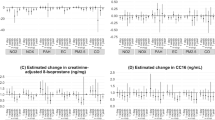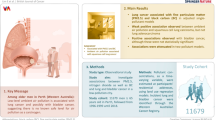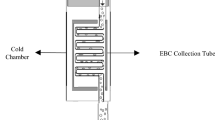Abstract
Underlying mechanisms by which air pollutants adversely affect human health remain poorly understood. Oxidative stress has been considered as a potential mechanism that may promote lipid peroxidation by reactive oxygen species, leading to the formation of malondialdehyde (MDA) that is excreted in biofluids (e.g., urine and exhaled breath condensate (EBC)). A panel study was conducted to examine whether concentrations of MDA in EBC and urine were associated, respectively, with changes in air pollution levels brought by the Beijing Olympic air pollution control measures. EBC and urine samples from 125 healthy adults were collected twice in each of the pre-, during-, and post-Olympic periods. Period-specific means of MDA and changes in MDA levels associated with increases in 24-h average pollutant concentrations were estimated using linear mixed-effects models. From the pre- to the during-Olympic period, when concentrations of most pollutants decreased, EBC MDA and urinary MDA significantly decreased by 24% (P<0.0001) and 28% (P=0.0002), respectively. From the during-Olympic to the post-Olympic period, when concentrations of most pollutants increased, EBC MDA and urinary MDA increased by 28% (P=0.094) and 55% (P=0.046), respectively. Furthermore, the largest increases in EBC MDA associated with one interquartile range (IQR) increases in all pollutants but ozone ranged from 10% (95% CI: 2%, 18%) to 19% (95% CI: 14%, 25%). The largest increases in urinary MDA associated with IQR increases in pollutant concentration ranged from 9% (95%: 0.3%, 19%) to 15% (95% CI: 3%, 28%). These findings support the utility of EBC MDA as a biomarker of oxidative stress in the respiratory tract and urinary MDA as a biomarker of systemic oxidative stress in relation to air pollution exposure in healthy young adults. Both EBC and urine samples can be collected noninvasively in the general population.
This is a preview of subscription content, access via your institution
Access options
Subscribe to this journal
Receive 6 print issues and online access
$259.00 per year
only $43.17 per issue
Buy this article
- Purchase on Springer Link
- Instant access to full article PDF
Prices may be subject to local taxes which are calculated during checkout



Similar content being viewed by others
References
Finkel T, Holbrook NJ . Oxidants, oxidative stress and the biology of ageing. Nature 2000; 408: 239–247.
Yang W, Omaye ST . Air pollutants, oxidative stress and human health. Mutat Res 2009; 674: 45–54.
Muller FL, Lustgarten MS, Jang Y, Richardson A, Van Remmen H . Trends in oxidative aging theories. Free Radic Biol Med 2007; 43: 477–503.
Rappaport SM . Implications of the exposome for exposure science. J Expo Sci Environ Epidemiol 2011; 21: 5–9.
Del Rio D, Stewart AJ, Pellegrini N . A review of recent studies on malondialdehyde as toxic molecule and biological marker of oxidative stress. Nutr Metab Cardiovasc Dis 2005; 15: 316–328.
Moison RM, Palinckx JJ, Roest M, Houdkamp E, Berger HM . Induction of lipid peroxidation of pulmonary surfactant by plasma of preterm babies. Lancet 1993; 341: 79–82.
Davies SW, Ranjadayalan K, Wickens DG, Dormandy TL, Timmis AD . Lipid peroxidation associated with successful thrombolysis. Lancet 1990; 335: 741–743.
Halliwell B, Gutteridge JM . Lipid peroxidation, oxygen radicals, cell damage, and antioxidant therapy. Lancet 1984; 1: 1396–1397.
Morrow JD, Frei B, Longmire AW, Gaziano JM, Lynch SM, Shyr Y et al Increase in circulating products of lipid peroxidation (F2-isoprostanes) in smokers. Smoking as a cause of oxidative damage. N Engl J Med 1995; 332: 1198–1203.
Chen C, Arjomandi M, Balmes J, Tager I, Holland N . Effects of chronic and acute ozone exposure on lipid peroxidation and antioxidant capacity in healthy young adults. Environ Health Perspect 2007; 115: 1732–1737.
Romero FJ, Bosch-Morell F, Romero MJ, Jareno EJ, Romero B, Marin N et al Lipid peroxidation products and antioxidants in human disease. Environ Health Perspect 1998; 106 (Suppl 5): 1229–1234.
Frankel EN, Neff WE . Formation of malonaldehyde from lipid oxidation-products. Biochim Biophys Acta 1983; 754: 264–270.
Lykkesfeldt J . Malondialdehyde as biomarker of oxidative damage to lipids caused by smoking. Clin Chim Acta 2007; 380: 50–58.
Niedernhofer LJ, Daniels JS, Rouzer CA, Greene RE, LJ Marnett . Malondialdehyde, a product of lipid peroxidation, is mutagenic in human cells. J Biol Chem 2003; 278: 31426–31433.
Dierckx N, Horvath G, van Gils C, Vertommen J, van de Vliet J, De Leeuw I et al Oxidative stress status in patients with diabetes mellitus: relationship to diet. Eur J Clin Nutr 2003; 57: 999–1008.
Gonenc A, Ozkan Y, Torun M, Simsek B . Plasma malondialdehyde (MDA) levels in breast and lung cancer patients. J Clin Pharm Ther 2001; 26: 141–144.
Tamer L, Sucu N, Polat G, Ercan B, Aytacoglu B, Yucebilgic G et al Decreased serum total antioxidant status and erythrocyte-reduced glutathione levels are associated with increased serum malondialdehyde in atherosclerotic patients. Arch Med Res 2002; 33: 257–260.
Corradi M, Rubinstein I, Andreoli R, Manini P, Caglieri A, Poli D et al Aldehydes in exhaled breath condensate of patients with chronic obstructive pulmonary disease. Am J Respir Crit Care Med 2003; 167: 1380–1386.
Kelly FJ . Oxidative stress: its role in air pollution and adverse health effects. Occup Environ Med 2003; 60: 612–616.
Lodovici M, Bigagli E . Oxidative stress and air pollution exposure. J Toxicol 2011; 2011: 487074.
Liu L, Poon R, Chen L, Frescura AM, Montuschi P, Ciabattoni G et al Acute effects of air pollution on pulmonary function, airway inflammation, and oxidative stress in asthmatic children. Environ Health Perspect 2009; 117: 668–674.
Chuang KJ, Chan CC, Su TC, Lee CT, Tang CS . The effect of urban air pollution on inflammation, oxidative stress, coagulation, and autonomic dysfunction in young adults. Am J Respir Crit Care Med 2007; 176: 370–376.
Kelly FJ, Sandstrom T . Air pollution, oxidative stress, and allergic response. Lancet 2004; 363: 95–96.
Barregard L, Saellsten G, Andersson L, Almstrand AC, Gustafson P, Andersson M et al Experimental exposure to wood smoke: effects on airway inflammation and oxidative stress. Occup Environ Med 2008; 65: 319–324.
Isik B, Hamamci C, Isik R . Effect of winter air pollution on lipid peroxidation product levels of patients with chronic obstructive pulmonary disease. Asian J Chem 2006; 18: 1433–1436.
Romieu I, Barraza-Villarreal A, Escamilla-Nunez C, Almstrand AC, Diaz-Sanchez D, Sly PD et al Exhaled breath malondialdehyde as a marker of effect of exposure to air pollution in children with asthma. J Allergy Clin Immunol 2008; 121: 903–909, e906.
Bae S, Pan XC, Kim SY, Park K, Kim YH, Kim H et al Exposures to particulate matter and polycyclic aromatic hydrocarbons and oxidative stress in schoolchildren. Environ Health Perspect 2010; 118: 579–583.
Pan CH, Chan CC, Huang YL, Wu KY . Urinary 1-hydroxypyrene and malondialdehyde in male workers in Chinese restaurants. Occup Environ Med 2008; 65: 732–735.
Wang M, Zhu T, Zheng J, Zhang RY, Zhang SQ, Xie XX et al Use of a mobile laboratory to evaluate changes in on-road air pollutants during the Beijing 2008 Summer Olympics. Atmos Chem Phys 2009; 9: 8247–8263.
Kipen H, Rich D, Huang W, Zhu T, Wang G, Hu M et al Measurement of inflammation and oxidative stress following drastic changes in air pollution during the Beijing Olympics: a panel study approach. Ann N Y Acad Sci 2010; 1203: 160–167.
Rich DQ, Kipen HM, Huang W, Wang G, Wang Y, Zhu P et al Association between changes in air pollution levels during the Beijing Olympics and biomarkers of inflammation and thrombosis in healthy young adults. J Am Med Assoc 2012; 307: 2068–2078.
Larstad M, Ljungkvist G, Olin AC, Toren K . Determination of malondialdehyde in breath condensate by high-performance liquid chromatography with fluorescence detection. J Chromatogr B 2002; 766: 107–114.
Wang T, Xie SD . Assessment of traffic-related air pollution in the urban streets before and during the 2008 Beijing Olympic Games traffic control period. Atmos Environ 2009; 43: 5682–5690.
Anderson HR, Ponce de Leon A, Bland JM, Bower JS, Emberlin J, Strachan DP . Air pollution, pollens, and daily admissions for asthma in London 1987-92. Thorax 1998; 53: 842–848.
Hajat S, Haines A, Goubet SA, Atkinson RW, Anderson HR . Association of air pollution with daily GP consultations for asthma and other lower respiratory conditions in London. Thorax 1999; 54: 597–605.
Lauwerys RR, Hoet P . Industrial Chemical Exposure: Guidelines for Biological Monitoring . 2nd edn Boca Raton Lewis Publishers. 1993.
Bartoli ML, Novelli F, Costa F, Malagrino L, Melosini L, Bacci E et al Malondialdehyde in exhaled breath condensate as a marker of oxidative stress in different pulmonary diseases. Mediat Inflamm 2011; 2011: 891752.
Corradi M, Folesani G, Andreoli R, Manini P, Bodini A, Piacentini G et al Aldehydes and glutathione in exhaled breath condensate of children with asthma exacerbation. Am J Respir Crit Care Med 2003; 167: 395–399.
Kim K, Park EY, Lee KH, Park JD, Kim YD, Hong YC . Differential oxidative stress response in young children and the elderly following exposure to PM(2.5). Environ Health Prev Med 2009; 14: 60–66.
Sacks JD, Stanek LW, Luben TJ, Johns DO, Buckley BJ, Brown JS et al Particulate matter-induced health effects: who is susceptible? Environ Health Perspect 2011; 119: 446–454.
Acknowledgements
We thank all the students and staff from Dr Tong Zhu and Dr Min Hu’s labs for their assistance in air pollution monitoring. This research was jointly funded by NIEHS (1R01 ES0158640, P30 ES05022, and 5P30ES007048) and the Health Effects Institute (4760-RPFA05-3). T.Z. is partly funded by Beijing Environmental Protection Agency (OITC-G08026056). The views expressed in this manuscript are solely of the authors and do not necessarily reflect those of the funding agencies.
Author information
Authors and Affiliations
Corresponding author
Ethics declarations
Competing interests
The authors declare no conflict of interest.
Additional information
Supplementary Information accompanies the paper on the Journal of Exposure Science and Environmental Epidemiology website
Supplementary information
Rights and permissions
About this article
Cite this article
Gong, J., Zhu, T., Kipen, H. et al. Malondialdehyde in exhaled breath condensate and urine as a biomarker of air pollution induced oxidative stress. J Expo Sci Environ Epidemiol 23, 322–327 (2013). https://doi.org/10.1038/jes.2012.127
Received:
Revised:
Accepted:
Published:
Issue Date:
DOI: https://doi.org/10.1038/jes.2012.127
Keywords
This article is cited by
-
Metal and oxidative potential exposure through particle inhalation and oxidative stress biomarkers: a 2-week pilot prospective study among Parisian subway workers
International Archives of Occupational and Environmental Health (2024)
-
Malondialdehyde and anion patterns in exhaled breath condensate among subway workers
Particle and Fibre Toxicology (2022)
-
Effects of particulate matter gamma radiation on oxidative stress biomarkers in COPD patients
Journal of Exposure Science & Environmental Epidemiology (2021)
-
Interstitial Lung Diseases and Air Pollution: Narrative Review of Literature
Pulmonary Therapy (2021)
-
The effects of facemasks on airway inflammation and endothelial dysfunction in healthy young adults: a double-blind, randomized, controlled crossover study
Particle and Fibre Toxicology (2018)



